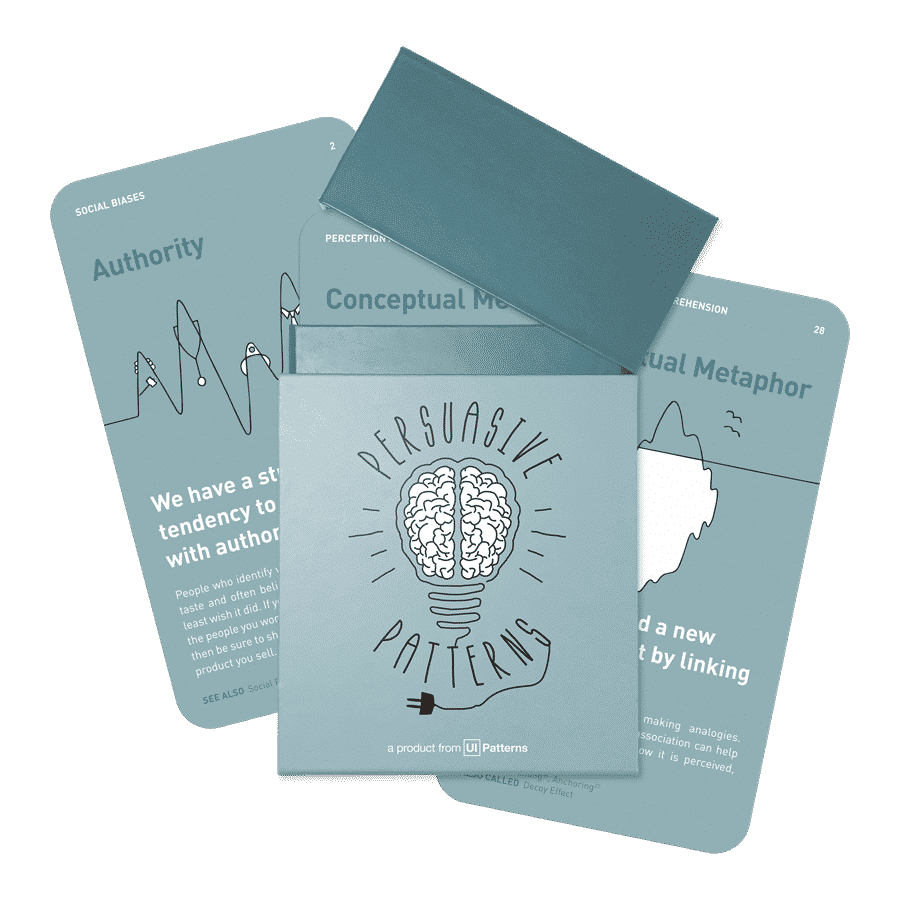Adding sensory signals to products improves both perception and use
People are willing to pay more for products with a pleasing sensory experience
Turn insights into action with the Persuasive Patterns card deck
Master the science behind user motivation and create products that drive behavior.
Get your deck!Ever debated between two seemingly identical products? Maybe it’s a pair of running shoes – one feels light and airy, the other a bit more substantial. Or perhaps it’s a new razor blade – one glides effortlessly, the other offers a slight resistance. We all know that feeling, that subtle nudge towards one option over the other. But what if I told you this decision might not be based solely on logic, but on something far more primal – product sensations?

A recent study by Dan King et al. (2024) unveils the fascinating world of these sensations and their surprising impact on our perception of a product’s effectiveness. It turns out, the way something feels, sounds, or even clicks can significantly influence how much we like it and how well we think it works. King et al.’s research delves deeper, exploring the nuances of how these sensations influence our behavior and perception.
Study: King, D., Auschaitrakul, S., & You, Y. (2024). Felt something, hence it works: Merely adding a sensory signal to a product improves objective measures of product efficacy and product evaluations. Journal of the Academy of Marketing Science.
The power of touch: More than meets the eye
Think back to your favorite pair of running shoes. Remember that feeling of security and support as you lace them up? Or maybe it’s that delightful bounce with each stride. King et al.’s study suggests this feeling isn’t just a happy coincidence. It’s a sensory cue, a tactile feedback loop that tells our brains the shoes are doing their job. They’re not just footwear; they’re an extension of your body, working in harmony with your movement.
The study goes beyond simple texture, highlighting the concept of congruence. Imagine a pair of running shoes designed for speed and agility. They might have a sleek, lightweight design and a slightly aggressive tread pattern. The feel of the shoe – lightweight, flexible – aligns perfectly with the visual cues and reinforces the message of speed. This congruence between sensory experience and product purpose creates a powerful effect on our perception.
This concept extends far beyond athletic wear. Studies show that people are willing to pay more for products with a pleasing texture, but the ideal texture can vary depending on the product category. A luxuriously soft bathrobe or a smooth, cool phone case can create a sense of quality and care, enhancing the overall user experience. Imagine settling into a plush bathrobe after a long day – the softness immediately evokes feelings of relaxation and comfort, subconsciously reinforcing the product’s value.
Digital product sense
But sensations aren’t limited to touch. The digital world relies heavily on auditory feedback to create a sense of control and confirmation. Think about the satisfying “click” you hear when you lock your phone or the reassuring whirring of a coffee grinder. These sounds create a positive association with the action, reinforcing the idea that something is happening behind the scenes. Imagine trying to lock your phone without that audible click – it might feel slightly unsettling, like the action wasn’t completed properly.
The study also highlights the potential of haptic feedback. Imagine a fitness tracker that vibrates slightly with each completed workout or a smartwatch that buzzes gently when you receive a notification. These subtle sensations create a sense of engagement and interaction, making the digital experience feel more tangible and immediate. A fitness tracker with a simple progress bar might convey information, but a tracker that vibrates with each step adds a layer of encouragement and satisfaction, motivating you to keep moving.
King et al. examines the concept of modal congruency here as well. Imagine a fitness tracker with a high-resolution display and a sleek, metallic design. The visual cues suggest a premium product, and the haptic feedback should ideally match that perception. A cheap, plasticky vibration would disrupt this congruency and diminish the overall user experience. In essence, the type of auditory or haptic feedback should complement the visual design to create a cohesive and satisfying sensory experience.
The promise of the Placebo Effect
Not all products can inherently incorporate a physical sensation. But fear not! King et al. explore the concept of placebo sensations. This involves carefully describing the sensations users can expect after using a product.
For example, imagine a new laundry detergent that promises long-lasting freshness. The packaging might highlight that clothes will “feel noticeably softer” or “retain a clean scent throughout the day.” These descriptive cues, while not physical sensations themselves, can trigger our brains to anticipate those experiences. When we take a whiff of our freshly-washed clothes and detect a hint of that clean scent, it confirms the product’s effectiveness, even if the scent itself is subtle.
The study delves a bit deeper, exploring the idea of metacognition. When we experience a placebo sensation, we don’t just feel it; we think about it. We might think, “This shirt feels softer, so the detergent must be working!” This mental process, known as metacognition, plays a crucial role in reinforcing the positive association between the product and the desired outcome.
By incorporating product sensations – whether physical, placebo, or digital – you can create a more engaging and effective user experience. Sensory feedback builds user confidence, fosters a sense of product efficacy, and ultimately, can lead to increased satisfaction and loyalty.
Key takeaways
- Physical sensations: Explore vibrations, tactile textures, or other relevant sensations to enhance user perception.
- Placebo sensations: Describe expected physical sensations users will experience to create a sense of product efficacy.
- Digital sensations: Utilize sounds, animations, or haptic feedback to reassure users that their actions have registered successfully.
So next time you’re designing or marketing a product, don’t just focus on features and functionality. Consider the sensory experience you want to create. How does it feel in the hand? What sounds or vibrations reinforce its purpose? Can you leverage descriptive language to build anticipation around its benefits?
By incorporating these subtle yet powerful elements, you can transform your product from a collection of features into a truly memorable experience.
A happy customer isn’t just a satisfied customer; it’s a customer who feels the difference, quite literally. They perceive the product as working because they can feel it, hear it, or even anticipate the sensations it promises.
- Felt something, hence it works: Merely adding a sensory signal to a product improves objective measures of product efficacy and product evaluations. by King, D., Auschaitrakul, S., & You, Y.
